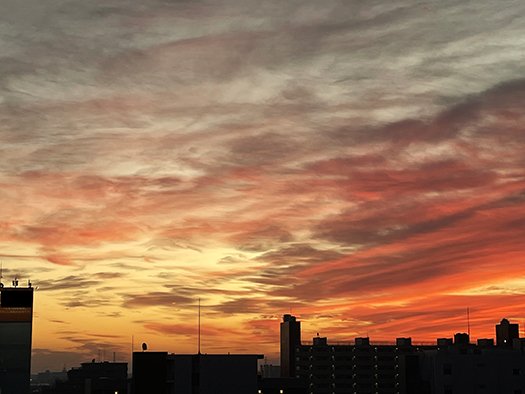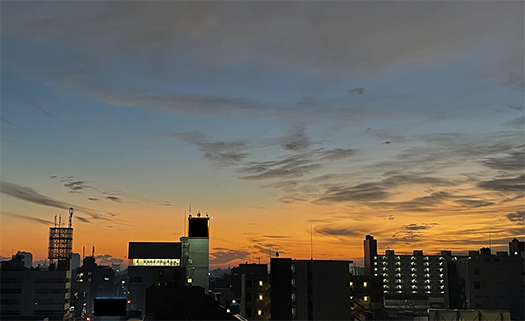

仕事上では最近、新事業のこともあって
水面下での動きが主流になってくるので当然書きにくい事柄が多い。
ということでブログではやや一般的な興味分野についての話題が増えてきます。
やむを得ない状況のなかであります。
で、究極的に「雲をつかむような」話題ということです(笑)。
写真は最近の出張時に見ていたホテルの部屋からの朝の雲の様子。
動物は「天気」という自然条件によって毎日の行動に制約が掛かってくる。
天気のいい日には「遠くまで行く」という心情を呼びやすいし
雨模様の日には「あんまり外には出ないようにしよう」というふうに考える。
「雲行き」というコトバは人間生活の基本決定要因。
そして人間は生きてきた日数だけ、空模様とは対話し続けてきている。
しかし当然ながら、風土性には世界各地、日本各地で違いがある。
雲というのはその土地の水分を反映するものでもあるでしょうから
結果として、その場所で出会う雲の様子とは一期一会のものだろうと思う。
青春期にはじめて海外旅行をしたとき、ローマに降り立って
地中海気候の半島部に沸き立つ雲の様子を見て
「え、雲の表情がこんなにも違う・・・」と強い印象を持った。
最近の「地球史」主に気候変動と地形変動の研究などをチラ見すると
こういう直感印象には大きな根拠があるのだと気付かされます。
日本列島というのはアジア大陸から分離して
その後、生成された日本海と、ヒマラヤ山脈からの偏西風によって
独特の気候環境がもたらされた、というように分析されてきている。
四季変化がここまで明瞭である風土というのは実は奇跡的で
そういった特異性は雲のさまざまな表情に正確に反映されているのではないか、
自然な直感としてそのように思っています。
日本海と太平洋に挟まれた気候風土条件はイタリア半島とも通じるものが
あるのかもしれない。
わかいときにこころに芽生えたこういう気付きに
長い年月経過後に再度、気になって仕方なくなってしまう(笑)。
人生時間には定量というものがあるのだから、
少なくとも自分という記憶装置に芽生えた素朴な印象、疑問については
なにがしかの「解」を求めてみたい、そう考えるのは自然。
で、この写真に現れた雲からのメッセージについて
そこにはやはりその土地の大状況が反映していることは間違いがない。
場所は千葉県内陸部地域であり、そこから東方向、太平洋側を向いた方向。
関東平野の広がりと房総半島的な両方の要素が表れるのでしょう。
広大な平野部を反映した雲が、空というキャンパス上で
一期一会で踊る光景からどんな超メッセージが伝わってくるのか?
すこしずつ、学びを深めていきたいと思っています。
English version⬇
A Long Dialogue with Clouds: The Earth’s Breath 2
The combination of Japan’s volcanic terrain, the steam from the Sea of Japan, and the westerly winds from the Himalayas creates a unique cloud formations on the earth. Gaze at the clouds that reflect this. The clouds reflect this.
On the job, I’ve been working on some new projects lately.
In my work, there are many matters that are naturally difficult to write about, since they are mainly underwater activities.
This means that my blog will increasingly focus on topics of general interest.
This is an unavoidable situation.
So, ultimately, I am talking about topics that “catch the clouds” (laughs).
The photo shows the morning clouds from my hotel room during a recent business trip.
Animals are constrained in their daily activities by the natural conditions of “weather.
On a sunny day, it is easy to call to mind “going far away,” and
On a rainy day, they think, “I should not go out too much.
The word “cloudiness” is a basic determinant of human life.
And humans have been interacting with the sky for as many days as they have lived.
Naturally, however, there are differences in the climate of different parts of the world and of different parts of Japan.
Clouds are probably a reflection of the moisture content of the land.
As a result, I believe that the clouds one encounters in a particular place are a once-in-a-lifetime occurrence.
When I traveled abroad for the first time in my youth, I landed in Rome and
I landed in Rome and saw the clouds rising over a peninsula with a Mediterranean climate.
I had a strong impression that the clouds looked so different from each other.
When I glanced at recent studies on the history of the earth, mainly on climate change and landform change, I found that there was a great deal of evidence for this intuitive impression.
I realize that these intuitive impressions have a great basis.
The Japanese archipelago was separated from the Asian continent
The Sea of Japan and the prevailing westerly winds from the Himalayas have created a unique climatic environment.
The Japan Sea and the prevailing westerly winds from the Himalayas have brought about a unique climatic environment.
It is actually a miracle that the four seasons are so distinct.
I have a natural intuition that such peculiarities are accurately reflected in the various expressions of clouds.
This is my natural intuition.
The climatic conditions between the Sea of Japan and the Pacific Ocean may have something in common with the Italian peninsula.
It may have something in common with the Italian peninsula.
This realization, which sprouted in my heart when I was young, will come back to me again after many years.
I can’t help but become curious again after a long time has passed (laughs).
There is a fixed amount of time in life.
I should at least seek some kind of “solution” for the simple impression or question that sprouted in the memory device called myself.
It is natural to want to seek some kind of “solution” to at least the simple impressions and questions that have sprouted in one’s memory.
And, as for the message from the clouds in this photo
There is no doubt that the message from the clouds in this photo is a reflection of the local conditions.
The location is the inland region of Chiba Prefecture, and the direction from there is toward the east, facing the Pacific Ocean.
It would show both the expanse of the Kanto Plain and the Boso Peninsula-like elements.
Clouds reflecting the vast plain on the campus called the sky.
What kind of super-message will be conveyed from the scene that dances in a single lifetime?
I would like to deepen my study little by little.
Posted on 11月 8th, 2022 by 三木 奎吾
Filed under: 未分類







コメントを投稿
「※誹謗中傷や、悪意のある書き込み、営利目的などのコメントを防ぐために、投稿された全てのコメントは一時的に保留されますのでご了承ください。」
You must be logged in to post a comment.